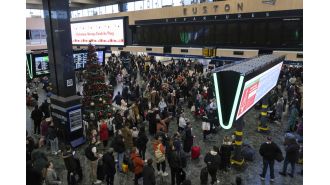Lessons From Bessemer: What Amazon’s Union Defeat Means for the American Labor Movement
Did the failed vote in Alabama deliver a fatal blow to employees’ union efforts, or is it just a temporary setback? History offers a few clues.

When Amazon opened its second fulfillment center in the Baltimore region, in 2018, most anyone driving to it from the city arrived via Dundalk Avenue, which took them past a yellow brick building that was constructed in 1952 to house Local 2609 and 2610 of the United Steelworkers and an adjacent building that opened after Local 2610 moved into its own space.
By then, the buildings were mostly vacant, because the steel mill whose workers the union had represented had closed, in 2012, after a long, steady decline. The Bethlehem Steel works were once the largest in the world, an industrial sprawl on the Sparrows Point peninsula that employed some 30,000 people, several thousand of whom lived in an adjoining company town. The work had been grueling and frequently treacherous since the mill’s founding, in the 1890s: “Always More Production” was the slogan of Eugene Grace, Bethlehem Steel’s president from 1916 to 1945. And, in the early decades of the 20th century, a disproportionate share of the fruits of the workers’ labor flowed to the top: Grace’s predecessor split his time between a mansion on Riverside Drive, in New York, which with 75 rooms and a dining salon that could seat 250 was the largest residence in the city, and a 1,000-acre, 18-building estate in Pennsylvania, which required a staff of 70 and included a replica of a farming village in Normandy.
But the work had become safer and far better paid by the 1950s for one basic reason: in 1941, employees had voted to join the union. The unionization effort took half a century and had been met with fierce resistance from mill management, which had armed company police with several boxcars’ worth of submachine guns, rifles, shotguns and revolvers, and deployed an endless stream of anti-union messaging. “Outsiders have not been necessary in the past,” read one company manifesto. “Nothing has happened to make them necessary now.”
What allowed a free union election at Sparrows Point to finally go forward was the Second World War and the company’s fear of losing out on military contracts from the labor-friendly Roosevelt administration. Nearly 70% of workers voted for the union. “We got more money, that was important, sure,” one of them told the journalist Mark Reutter. “But we got respect more, that was number one.”
Today, 80 years later, the mill and the company town have been wiped almost entirely off of Sparrows Point. In their place stands a 3,100-acre business park, which includes the Amazon fulfillment center. Workers there have, in a sense, returned to the point in the economic cycle where the steelworkers of the early 20th century had been. In the fall of 2018, the wage for Amazon workers started at about $14 an hour, about a third of what rank-and-file workers had been making at the steel mill in its final years. They would be working for a company that was synonymous with extreme inequality. Its CEO had just become the richest man in the world, and he, too, had a taste for luxury real estate, with holdings that included the most expensive residence in Washington, D.C., on which he had spent $35 million, and which contained 25 bathrooms. They would be at far less risk of serious injury, but they would face extraordinarily high demands from a company that had, essentially, adopted “Always More Production” as its own mantra, except that production, in this case, was not making steel for bridges, tunnels and skyscrapers, but rather stowing and picking and packing products made elsewhere.
And these workers would, like those initial generations at the Point, lack union representation. That, too, had been swept off the peninsula.
These were the stakes, then, for the union election held over the past two months at the Amazon fulfillment center in Bessemer, Alabama (a town named for the British inventor who devised the modern steelmaking process): Would it be the first step in giving the cycle of economic history a new turn, and bringing today’s logistics work closer to the compensation and respect commanded by the manufacturing work that had preceded it? Work in an Amazon warehouse has not only replaced manufacturing at Sparrows Point, but it has also replaced it, more generally, as a new mass-employment option for Americans without a college degree or specialized training. During the past year alone, Amazon has added about 400,000 employees in the U.S., to handle the great pandemic e-commerce surge, bringing the company’s total U.S. workforce to more than 800,000, second only to Walmart — and that doesn’t include the hundreds of thousands of drivers, who despite delivering Amazon packages in Amazon trucks and wearing Amazon jerseys are technically employed as contractors.
Amazon is increasingly defining what entry-level labor now looks like in America, not least because the company’s dominance across so many sectors of the economy is leading rivals to adopt its ways. This new form of work has replaced countless brick-and-mortar retail jobs, but it is more physically taxing than those jobs; it is also less remunerative and purposeful than much of the assembly-line work it more closely resembles. The jobs are highly repetitive and relentless, and have become only more so as the warehouses have become further automated, with more robots for workers to keep pace with and more surveillance tools to track their performance. The jobs are also highly isolating, a situation made worse by the pandemic, when people who had once worked together were spaced out to deter contagion. In addition to raising pay, which now starts at slightly above $15 an hour, one of the chief goals of union activism at the company has been to ratchet back the relentlessness and make the jobs more sustainable; as it now stands, many warehouses experience 100% turnover per year. “They feel like they’re robots being managed by other robots, where every motion they make is monitored, where they’re expected to maintain an unbearable pace, where Amazon seems to dehumanize them,” Stuart Appelbaum, the president of the Retail, Wholesale and Department Store Union, said.
Workers at the Bessemer warehouse contacted the RWDSU in late summer of last year about wanting to hold a union vote. In November, the union announced it had collected enough cards of support to hold an election. This was a major breakthrough at Amazon, where unions had previously mustered only one election, a failed effort, in 2014, to organize a small group of technicians at a warehouse in Delaware. Amid widespread amazement that the first election at a full Amazon warehouse would be taking place in the Deep South, there were also skeptical rumblings from many veterans of organized labor about the RWDSU’s decision to forge ahead. The skeptics noted the ominous signs, most notably the fact that the company had succeeded in defining the size of the warehouse unit more broadly than the union had expected, including supervisory types and temporary workers in the group, which would make it harder for the union to achieve a majority.
It was also inauspicious that so few workers were willing to go public with their support for the union, by signing petitions or wearing buttons or otherwise, which many organizers consider essential for exuding confidence and momentum, but which RWDSU organizers had judged too risky, given Amazon’s reputation for retaliating against activist workers. “If you cannot create a credible internal organization that is willing to be out front with the boss, you lose,” Peter Olney, the former organizing director of the International Longshore and Warehouse Union, who, in 2008, led a successful fight to organize workers at a large Rite Aid warehouse in Los Angeles County, said. He wondered whether a better approach than union elections at warehouses was, for now, to focus on strikes and other work disruptions at key points in the Amazon supply chain, not unlike what autoworkers had pulled off in sit-down strikes in Atlanta, Cleveland and Flint, Michigan, in 1936 and 1937, which led to the United Auto Workers’ first contracts with General Motors.
Meanwhile, Amazon was pulling out the stops: pressing the Postal Service to install a mailbox outside the warehouse for workers to drop off ballots, which the union said gave the impression that the company was monitoring votes; changing the timing of stoplights near the facility, to make it harder for organizers to approach workers as they left work; and, above all, delivering a stream of anti-union messages in mandatory workplace meetings. “They were cool. They were just telling us what the union did,” Jeremiah Okai, a 19-year-old Amazon worker, told the labor reporter Mike Elk. As for “what the union did,” workers’ comments suggested that the company’s version elided that, in a so-called “right-to-work” state like Alabama, workers could choose whether or not to pay dues to the union. “They’re going to take money away from me,” Okai said. “And I don’t want no money taken away from me.”
“Abandon All Hope Ye Who Enter Here” read an 1891 headline in Baltimore’s labor newspaper about the new steel mill at Sparrows Point. Workers had to sign a “Conditions of Employment” slip that listed “agitation” and “insubordination” as grounds for firing, and those living in the company town risked losing their home if they were seen as being too restive. For years, Bethlehem Steel staved off worker and government pressure for more workplace representation by trumpeting its in-house “employee representation plan,” claiming that as many as 97% of workers had voted in its favor.
As word came in last week of the RWDSU’s decisive loss in Bessemer — 1,798 to 738, with another 500 or so ballots still under challenge by Amazon — there was this consolation for organizers and their allies: these things took time, all the more so when the employer was as enormous as this one. Still, the numbers were stark, especially when one considered that barely half of the 5,876 workers who were eligible had even bothered to take part in the election.
Amazon seized on the results as evidence that employees were not nearly as unhappy with work conditions as organizers made out. “The union will say that Amazon won this election because we intimidated employees, but that’s not true,” the company said. “Amazon didn’t win — our employees made the choice to vote against joining a union.” And there were instant critiques of the union’s performance, growing out of those earlier rumbles: that it had forged on even after the pool of eligible voters included so many supervisors, that it had inadequately rebutted Amazon’s claims about paying dues, that it had failed to make house calls to workers out of excessive caution about COVID-19.
Appelbaum rejected these critiques when I spoke with him by phone on Sunday night. “There are a lot of armchair quarterbacks who were nowhere to be found in providing advice during the campaign,” he said. “To say, ‘We should have backed away,’ can you imagine what message that would have sent to the workers that desperately wanted us to come?” He was resolute that the effort had paid off. “I’m proud of the fact that we put the ball farther down the field than anyone has before,” he said. “We have shined a spotlight on working conditions at Amazon. The scrutiny of its labor practices is not going to go away.”
He was not alone in finding a bright side. Dania Rajendra, the director of the anti-Amazon coalition Athena, said that “phones had been ringing off the hook” as a result of the Bessemer push. “It’s a very helpful thing for more people to understand what collectively we’re all up against,” she said. One such major obstacle, she noted, was the group of existing laws around labor organizing, which tilted the field toward employers, helping explain why fewer than 7% of private-sector workers now belong to a union. (The House passed a bill last month to protect organizing, but it’s not expected to survive the Senate.)
Even Olney, despite his earlier critiques of the organizing effort in Bessemer, was reluctant to declare the election a total loss. “There were obviously a lot of problems,” he said. “On the other hand, it’s important to salute the effort and impact that this had.” He told me that he was suddenly hearing far more interest from young labor activists about taking on Amazon than he had before. “It’s having reverberations.”
Still, it’s hard not to recall again the example of Sparrows Point, and what it was that had allowed workers there finally to succeed in joining the union: the Second World War and the company’s desire to profit from it. President Joe Biden took a major step ahead of the Bessemer vote by releasing a video affirming the right to free union elections, but he lacks the sweeping influence commanded by Roosevelt during wartime. One can’t help but wonder what sort of transformational event or outside force it would take to have a similar effect on Amazon and its workers, after this cataclysmic year that served to make the company only that much larger and more dominant.






